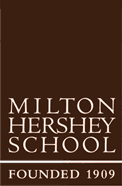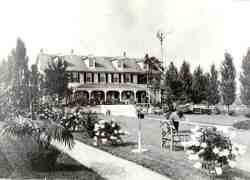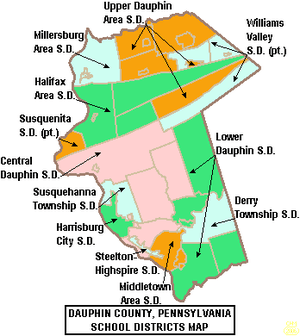Milton Hershey School
The Milton Hershey School is a private philanthropic (pre-K through 12) boarding school in Hershey, Pennsylvania. Originally named the Hershey Industrial School, the institution was founded and funded by chocolate industrialist Milton Snavely Hershey and his wife, Catherine Sweeney Hershey. The school was originally established for impoverished, healthy, male orphans, while today it serves students of various backgrounds. The Milton Hershey School Trust, which funds the school, owns controlling interest in The Hershey Company and owns the Hershey Entertainment and Resorts Company (HE&R) which oversees many of the area hotels along with a theme park called Hersheypark. With over $12 billion in assets,[4] the Milton Hershey School is one of the wealthiest schools in the world. The school is overseen by a Board of Managers.[5]
| Milton Hershey School | |
|---|---|
 | |
| Address | |
1201 Homestead Lane , 17033 United States | |
| Coordinates | 40°16′12″N 76°37′36″W |
| Information | |
| Type | Private boarding school |
| Established | November 15, 1909 |
| President | Peter G. Gurt[1] |
| Principal | Elementary Division: Tara Valoczki Middle Division: Ryan Michael |
| Faculty | 130 |
| Grades | Pre-K-12 |
| Number of students | <2,100 [2] |
| Campus size | 8,500 acres |
| Campus type | Rural |
| Color(s) | Gold & Brown |
| Athletics | football, soccer, track and field, cross country, baseball, softball, field hockey, swimming, diving, wrestling, cheerleading, basketball, hockey |
| Affiliation | The Hershey Company |
| Information | Office of Admissions: (800) 322-3248 |
| Endowment | $13.751 Billion USD (2015)[3] |
| Website | Official website |
History of the school
"It was Kitty's idea," Milton Hershey always said when he spoke of the Hershey Industrial School. “If we had helped a hundred children it would have all been worthwhile.”[6]
Fifteen years younger than her husband, Catherine Hershey developed an undiagnosable illness circa 1901, and was increasingly sickly for years.[7] Hershey's father, Henry, had been highly intelligent, but not too realistic; his get-rich schemes never worked too well. Hershey did not cope well with the instability; he had attended seven different schools, yet never made it into the fifth grade,[8] so when Kitty was unable to bear children, the Hersheys decided to give needy kids the kind of upbringing he never had. Milton and Catherine Hershey established a home and a school for “poor, healthy, male orphans between the ages of 8 through 18 years of age.”[6]
On November 15, 1909, Hershey signed over the 486-acre (1.97 km2) farm where he had been born, complete with livestock, to start the school. In 1910, Nelson (age 6), and his brother Irvin (age 4) were the first to arrive. Their father, who had worked as a polisher in a Mount Joy foundry, had died after a long illness, and their mother couldn't support six children by taking in laundry. Their brother William, 2, was too young to be admitted for two more years. Another pair of brothers, sons of an Evangelical church's pastor, arrived a few days later.[6] The first class consisted of 10 students,[9] and by 1914, there were 40 boys enrolled in the school.[6]
_(14595673537).jpg) | |
While Hershey consulted with experts on managing the school, he used three guiding principles to ensure the students had a good education, a sense of stability and security: every graduate should have a vocation, every student should learn love of God and man, and every student should benefit from wholesome responsibility. The vocational education program started with a woodworking shop, where the boys made their own beds and chests. Although Hershey was nonsectarian, claiming the "Silver Rule" as his religion, Sunday school was held regularly at the home. Starting in March 1929, the boys got the responsibility of doing daily chores in the dairy barns.[6]
After Kitty's death in 1915,[7] Hershey gave his entire personal fortune - thousands of acres of land, and controlling interest in the company, worth US$60 million - to the school. He continued to be involved in the school's operations until his death in 1945.[6]
The organizational papers were modified in 1933, allowing the school to accept older students, and again in 1951 to change the name of the school from the “Hershey Industrial School” to the “Milton Hershey School.” In 1968, the school was racially integrated, although it wasn't until 1970 that the organizational papers allowed that, and another modification in 1976 allowed female students, who started arriving in 1977.[6]
In 1989, the school stopped requiring students to milk cows twice daily, reflecting a changed focus from vocational to college preparatory education, but students were still required to perform chores.[6]
Students and student life

Admissions are based on five major admissions criteria: (1) Age, (2) Financial Need, (3) Social Need, (4) Potential To Learn, and (5) Geographic Preference.[10]
The school gives preference to students from Pennsylvania, and especially to students from Dauphin, Lancaster, and Lebanon counties.[10] Tri-county students account for 28% of the student body, with another 49% coming from elsewhere in Pennsylvania. The remaining 23% of the student body comes from 34 other states and from the District of Columbia.[11] In 1982, Milton Hershey School admitted its first international students, Ian and Edward Ritchie from Ottawa in Ontario, Canada.
As of 2009, the student population of the school is 1,818. Girls outnumber boys 945 to 873. The students are 46% Caucasian, 30% African American, 11% Hispanic, 1% Asian, less than 1% Native American and 12% other.[11] Approximately 47% of the students have siblings who also attend MHS.[12]
A married houseparent couple with child care experience provides full-time supervision for each residence, caring for 9 to 13 children of the same gender, and about the same age. A student will share his (or her) bedrooms with one or two other students.[12]
As of August 2007, all students in their Senior year live in the Transitional Living program, which places 4 students in an apartment, five apartments in a building, and two coordinators to oversee their actions. The program exists as a college-prep movement, in response to polls of MHS alumni which showed that many alumni felt unprepared for college. The TL program is notably more relaxed than the student homes, with fewer restrictions and rules. Transitional Living students are taught how to purchase food for themselves and are required to submit meal plans to their coordinators. According to the 2012 Health and Wellness Initiative introduced by the school, these meal plans must conform to healthy eating standards. They are additionally expected to maintain a regimented level of cleanliness throughout their apartments and common areas.
Students are "plainly, neatly, and comfortably clothed, without distinctive dress".[10] Students wear a uniform of "coordinated clothing" to classes and other designated school functions. School policies say students may have a limited amount of approved leisure and dress wear, and if the student's family or sponsor cannot buy it, the school will.[13]
Each child is encouraged to explore belief in God and in prayer, although the school is non-sectarian.[10] By school policy, students are required to attend a weekly Judeo-Christian chapel service on Sunday mornings.[14]
Student homes, academic buildings, and other facilities are mostly located within rough walking distance of one another. The centerpiece of the campus is Founders Hall with an auditorium seating 2700.[15]
In September 2007, the school opened its Springboard Academy, a program geared toward new incoming sixth and seventh graders, to help with transition into the core program. In 2008, the program changed from sixth and seventh graders to eighth graders. Springboard Academy was housed on its own campus, where about 84 students lived in cottage-like dormitories. The program featured a non-traditional curriculum, where reading and math skills were taught in an experience based setting. However, the program was designed to help reduce the attrition rate of students enrolling in Milton Hershey School, and after 3 years the program was shut down since no measurable evidence of its success could be established. The school's president, Dr. Anthony Colistra, officially announced the closing of the program in 2010[16]
Students are also encouraged to participate in activities such as visual and performing arts, athletics, student government association, mentoring/tutoring, and work-based learning.[17] The school has seen success in activities such as track and field, boys' basketball, boys' wrestling, and field hockey. Its athletic teams participate interscholastically in District 3's Mid-Penn Conference.
Milton Hershey School is one of the country’s best independent schools. It offers life-changing opportunities and experiences that other schools simply cannot. Everything is provided at no cost to students, thanks to the generosity of Milton and Catherine Hershey. The school is the nation's biggest and wealthiest boarding school for needy children, with $14 billion in assets for more than 2,100 students.[18]
Controversies
In December 2011, Milton Hershey School found itself in the midst of controversy after an HIV positive student was denied admission. In a lawsuit filed against the school on behalf of the unnamed boy, the AIDS Law Project of Pennsylvania claimed the school violated the Americans with Disabilities Act. School officials said that the boy was denied admission to protect other students. The school later apologized and offered the boy admission to the school, which he declined.[19] On September 12, 2012, the school reached a settlement with the AIDS Law Project of Pennsylvania in which the school would pay $700,000 to the student and his mother while also paying $15,000 in civil penalties and providing HIV training for students and staff members.[20]
In 2015, the school did not allow a student with a history of mental health and family struggles to attend graduation after 9 years at the school. The school claimed this was due to concerns about student safety, but this was in contrast with the conclusions the school psychologist had come to during an assessment. The student was devastated by this and died by suicide the week following her graduation date.
In May 2016, it was reported by The Philadelphia Inquirer that the school was being investigated by the U.S. Department of Justice for possible civil rights violations by not accepting students with physical disabilities and expelling those who present mental disabilities.[21] In July 2017, The Hummelstown Sun reported that the plaintiff dropped the federal lawsuit. [22]
In July 2017, court documents were filed by former student Adam Dobson. In July 2018, the "plaintiff respectfully withdraws his claims." [23] On May 6, 2020, Judge John E. Jones III dismissed Dobson's lawsuit, claiming that the lawsuit “failed to identify any basis in the record to conclude that what he characterizes as gay-conversion therapy resulted in the injuries he alleges.” [24]
Notable alumni
- Deesha Dyer, White House Social Secretary, graduated in 1995.
- Garry Gilliam, Penn State University offensive linesman and NFL player, graduated 2009
- Nellie King, a former major league pitcher for the Pittsburgh Pirates, graduated from the school in 1946.
- Alan Krashesky, news anchor for WLS-TV in Chicago, graduated 1978.[25]
- Trymaine Lee, Pulitzer Prize-winning journalist and national reporter for MSNBC.[26]
- Joe Senser, a former NFL star tight-end for the Minnesota Vikings, currently on the board of the Hershey Trust Company and Hershey Entertainment & Resorts Company, graduated from the school in 1974.
- Andrew Joseph Stack III, who flew a Piper Dakota airplane into an IRS Building in Austin, Texas as a tax protest in 2010. Graduated in 1974.
See also
References
- "Office of the President". Milton Hershey School. Retrieved April 18, 2018.
- "Brown & Gold Report | Milton Hershey School".
- "IRS Form 990 Milton Hershey School and School Trust" (PDF). Foundation Center. July 31, 2016. Retrieved April 18, 2018.
- "An Update to the Milton Hershey School Community from Velma Redmond". 2016-11-06.
- "Board of Managers of the Milton Hershey School". Milton Hershey School. Retrieved April 18, 2018.
- Hershey Chronicle, May 27, 1999 this was founded out by Catherine Hershey Milton Hershey School, retrieved September 22, 2006
- Catherine Sweeney Hershey, retrieved September 22, 1006
- Hershey History Archived 2005-11-25 at the Wayback Machine, retrieved September 22, 2006
- Admissions FAQ, retrieved June 30, 2020
- (1976), retrieved June 30, 2020
- Student Body Statistics Archived 2014-02-20 at the Wayback Machine, February 2014
- About Archived 2006-10-06 at the Wayback Machine, retrieved September 22, 2006
- Dress Code, retrieved September 22, 2006
- Religious programs, retrieved September 22, 2006
- Founder's Hall, retrieved September 22, 2006
- "Milton Hershey School to end Springboard Academy". 2010-04-09.
- "Milton Hershey School".
- CauseIQ, August 3, 2019
- The Milton Hershey School apologizes to HIV-positive student August 08, 2012, Kathy Boccella, The Philadelphia Inquirer
- "Hershey settles HIV suit with 14-year-old student denied school admission". CBS News. Hershey. Associated Press. September 13, 2012. Retrieved January 16, 2018.
- "Report: Milton Hershey School target of probe". Lebanon Daily News. May 20, 2016. Retrieved January 16, 2018.
- Buffington, Dave (July 6, 2017). "Buchan Drops Federal Case". The Hummelstown Sun.
- Miller, Barbara (October 25, 2017). "Court ruling tosses out negligence claims in lawsuits against Milton Hershey School". The Patriot-News. Retrieved January 16, 2018.
- "Order Closing Case Dobson v. Hershey" (PDF).
- Hauck, Darren (24 September 2019). "The Alan Krashesky Story You Won't Hear at 10". Chicago magazine. Retrieved 24 September 2019.
- "Trymaine Lee".
External links
- Official website

- Milton Hershey School and Milton Hershey the Man – Unofficial website with historical information about the school and Milton Hershey.
- The Association of Boarding Schools (TABS) school profile
